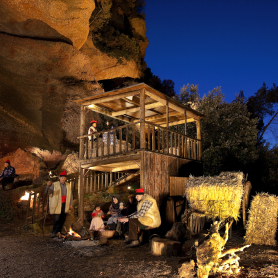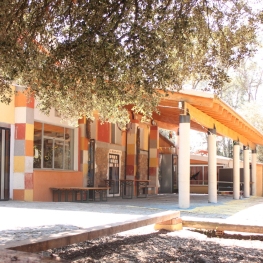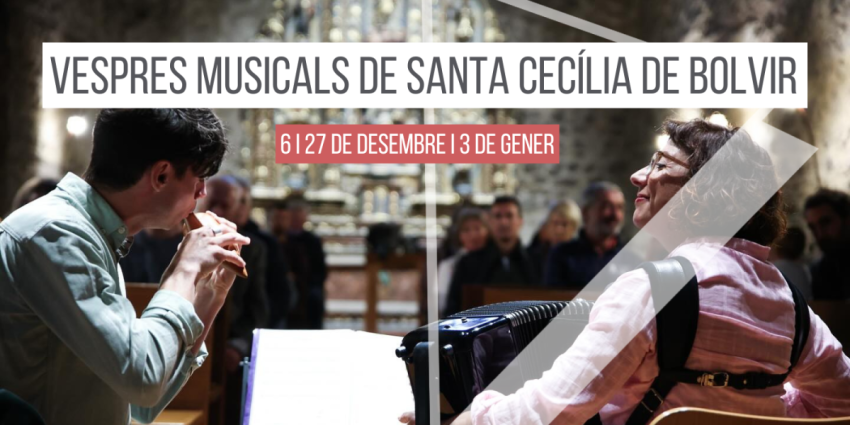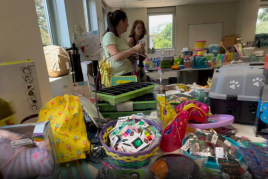Itinerary through the city of Martorell
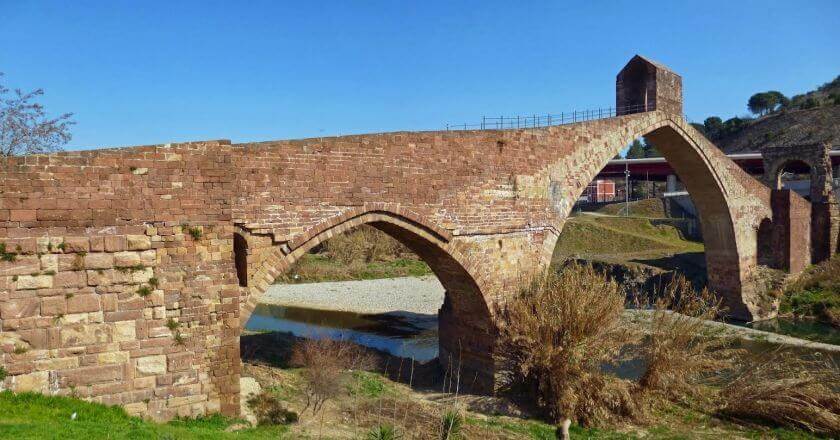
Martorell allows a wide range of possibilities to enjoy the historical heritage and the natural environment, on foot or by bicycle.
The tour of the Villa begins at the church of Santa María following the street of Francesc Santacana, the Plaza de la Villa, Anselm Clavé and Pere Puig, until it ends at the Puente del Diablo. If you arrive on the railways, you can choose the opposite route from the Martorell-Vila stop.
This itinerary coincides with the road to Santiago, that's why we'll find on the ground the typical shells that mark the way.
Parish Church of Santa María
We will start in the plaza of the parish church of Santa María. The first documented church was built in the 11th century in Romanesque style, although no remains were found. Later a temple was built mixing the Gothic and Renaissance styles.
The building was bombed during the Civil War and what we see today was built between 1941 and 1944 on the remains of the Gothic building. It is the work of the architect Francesc Folguera, assistant of Gaudí in the Sagrada Familia, and also collaborated the architect from Martorell, Josep Ros i Ros. The Renaissance portal located on the side, comes from the previous building and was preserved in the Vicenç Ros municipal museum until 1992.
The houses of the Villa
We will continue the visit through the street of Francesc Santacana and number 14 we will find the birthplace of the tenor Josep Palet (1877-Milan 1941), winner of the best theaters in Europe and America, which had one of the most extensive operatic repertoires of the time.
Next, on the corner of Calle del Agua, we find La Enrajolada - Casa Museo Santacana, founded in 1876 by Francesc Santacana i Campmany (1810-1896). It represents one of the oldest museums in our country. The building has four floors and a nice courtyard with garden. It has an eclectic background composed of tiles from the fourteenth to the twentieth centuries, ceramic pieces and paintings made by the same Francesc Santacana or painters with whom he was in contact.
Strolling down Calle Francesc Santacana, at number 23, we will find the birthplace of the composer Joan Cererols (1618-1680) musician and Benedictine monk of the Abbey of Montserrat, instrumentalist and composer of religious music.
In the plaza de la Villa number 7, there is the neo-classical building of Cal Nicolau, current school of music, built in 1834. The interior houses an important set of 19th century wall paintings of empire style. One of the rooms is called "Queen's room", in reference to Queen Elizabeth II who was staying here.
Following the same street, we will arrive at the Town Hall, former House of the procurators of the lords of Martorell. Built in the 16th century, it was modified over the years. In the second half of the nineteenth century, the last lord of Martorell, Florenci Cavero, the last Marquis of los Vélez, sold the building to his agent Antoni Buixeres, notary of Martorell. This change of ownership motivated that the old building, known until then as the house of the Marquis, was known by the new generations by the name of Cal Notari.
In 1937, in the original building, two higher levels were added and decoration based on sgraffito, work of the artist Ferran Serra, where the allegorical figures of the Anoia and Llobregat rivers are represented. It conserves at its lower level original elements such as the lintel portal or the window with lintel and stone jambs.
Air-raid shelter
Just in front of the Casa de la Villa, if you look at the ground, we find a slab where the anti-aircraft shelter is located . It was one of those built during the Civil War. It was located in 1990, as a result of the paving works of the square and given its good state of preservation. The City Council enables the visit once a year normally during the month of April coinciding with the celebration of the Spring Fair.
Of the antiaircraft shelter are currently preserved about 35 meters in length. It is 1.20 meters wide and between 1.80 and 2 meters high in the central part. It is located at a maximum depth of about 8 meters and is accessed by 27 steps. It is excavated in clay, its walls are covered with bricks bound with small doses of cement, the roof is barrel vault and the ground soil hardened.
In Plaza de la Villa 41 we find the Bujons Pharmacy, currently closed to the public for renovations. It remained open between 1842 and 1957. You can see its facade sgraffito by Ferran Serra with decorative elements typical of the use of the building as a pestle, a still or pharmacy boats.
Installed in the old Casa Par in the Plaza de las Horas, we discovered the Muxart Center, Contemporary Art and Creation Space, which since March 2011 has hosted a sample of the works of the artist from Jaume Muxart in Martorell born in 1922. The artist was part of the Taüll group, established in 1955, together with Antoni Tàpies among other artists.
Following the itinerary, on the street of Anselm Clavé, at number 8 we find the Gausa house, the oldest in the municipality, built around the 14th and 15th centuries and which is currently divided into two. The façade is made of squared stone and it conserves one of the two Gothic windows divided by two columns.
Chapel of San Juan
The chapel of San Juan, located on Pere Puig street 61, is documented in 1216 and is the only one that remains of the old Martorell hospital. It consists of a single nave with a pointed barrel vault and three pointed arches. From the 18th century they are the heart and the facade decorated with engravings by Jaume Amat.
The presbytery is presided by an altarpiece with altar. Two Solomonic columns with Ionic capitals decorated with screens and birds frame a painting on wood of the Virgin and Child from the 14th century.
The Devil's Bridge
Continuing along Pere Puig street, we will arrive at the Llobregat river bank on top of which we will find the Puente del Diablo. On the left are the remains of the chapel of San Bartolomé. Documented in the thirteenth century and known through engravings illustrating the bridge, it was destroyed in 1835. You can see the rectangular floor, with remains of the pavement and buttresses. The existence of an adjacent cemetery has been confirmed.
Undoubtedly, the most emblematic architectural element of Martorell is the Devil's Bridge. Of Roman origin (8-10 BC) it was part of the Augusta road that connected Cádiz with Rome.
Due to the flooding of the river, it has been redone several times. In 1283 a reconstruction was made in Gothic style, with two pointed arches. The last major reform was in 1962, after the Gothic arch was dynamited during the Civil War, but it was restored keeping the structure of the Gothic reform faithful.
The strategic importance of the bridge during the second half of the 18th century led to the construction of a cavalry barracks. Currently, Cuartel has been rebuilt and since 2011 it has been the headquarters of the Heritage Interpretation Center of Martorell that hosts several exhibitions.
If we want more...
If we want to extend the walk through the Villa, from the Plaza de las Horas we can go up to Calle del Muro to admire the Torre de las Horas (private property). It was the house of the philosopher Francesc Pujols and inside it is the library and memories of his work. With a square floor plan, it is topped by a viewing tower and the whole house is surrounded by a garden.
We crossed Calle del Muro and found El Progrés. Account with the building of the coffee of noucentista aesthetics inaugurated in 1928 and with room of shows of the year 1931 with dance floor and wooden boxes.
Going up by one of the sides, we reach the Vicenç Ros municipal museum and the Memorial. The museum is located in the old convent of the Capuchins, built in the seventeenth century, in which we can admire Catalan-themed religious compositions, hunting panels and an important ethnological background, such as wine boats, even tools and tools of different trades as well as the first car registered in Martorell. They also preserve decorative elements of the old parish church of Santa María as gargoyles , and the mechanism of the first clock located in Las Horas, one of the oldest in Catalonia.
What to do
Granja Aventura Park
Viladecavalls (a 9 Km)Come and enjoy a wild day at Granja de Aventura Park, a…
Pessebre Vivent de Corbera
Corbera de Llobregat (a 6.4 Km)The Living Nativity Scene of Corbera de Llobregat is a live representation…
Poble Espanyol Barcelona
Barcelona (a 14.4 Km)Discover Poble Espanyol in Barcelona, a space for all audiences where history…
Where to eat
Bar Muy Buenas
Barcelona (a 22.3 Km)Few words better define Muy Buenas than "coherence." Purely modernist decor, restored…
Taverna ümet
Sabadell (a 16.9 Km)Taverna Ümet is a restaurant in Sabadell offering creative tapas and flavorful…
Fàbrica Moritz Barcelona
Barcelona (a 21.9 Km)The Moritz Factory Barcelona is a unique space, divided into three floors,…
Where to sleep
Let's Holidays Castelldefels
Castelldefels (a 21.3 Km)We offer more than just a stay... Let's Holidays offers you a…
Aparthotel Silver
Barcelona (a 20 Km)Aparthotel Silver is one of the recommended establishments in Barcelona. It offers…
Hotel Hyatt Regency Barcelona Tower
Barcelona (a 20.5 Km)The Hyatt Regency Barcelona Tower hotel will offer you an unforgettable experience…





